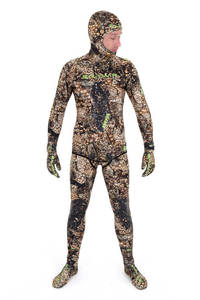In this ultimate guide to spearfishing wetsuits we take a look at why you really need a wetsuit, what to look for when buying one and the advantages and disadvantages of all the different types available.
We also give our opinion on the question of whether a camouflage wetsuit actually works and tell you what thickness wetsuit to wear in what temperature water.
We even show you an example of how to get into an open cell wetsuit and right at the end we list our favourite spearfishing suits - which was a surprisingly difficult task due to the number of great suits and manufactuters out there.
To be honest, even with this 3000+ word article we barely scratched the surface on spearfishing wetsuits. You can expect that we will greatly expand on this guide in the coming months and many of the sub-headings in the index below will become full articles of their own.
But first a sneak peak before we jump in to it...
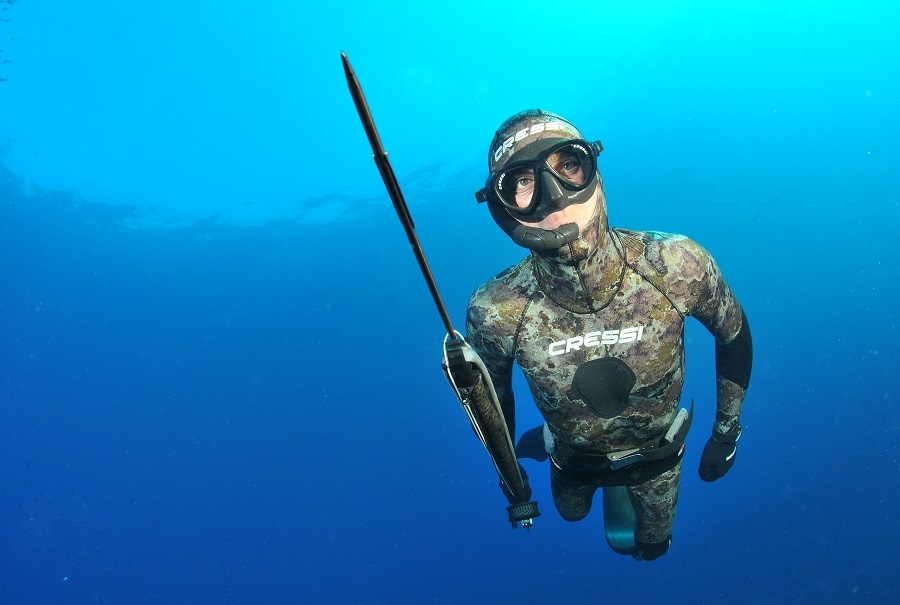
Why you need a spearfishing wetsuit
One of the greatest risks that a Freediver and especially spearfisherman face is not from sharks as the uninitiated would think but rather from the elements.
Cold water will get a diver clambering back on the boat or swimming back to shore long before he is ready to leave the fish for another day. And it’s not just the cold.
When you’re lying on the surface face-down with a snorkel in the mouth the sun can be just as unforgiving on your back and neck. Sunburn and sun-stroke can be just as bad as getting cold although the effects thereof is often only felt the next day.
And then there’s the other elements that you need to be aware off - jellyfish, man-o-war’s, fire corals, sharp crustaceans and rocks.
Even when divers don’t need to wear wetsuits because of the temperate waters they often still choose to wear a thin suit because of the protection that it offers from the sun and stinging sea creatures.
As a spearo in the water we are definitely out of our element and need something to protect us from everything that we might encounter. A spearfishing wetsuit creates that boundary of protection and even a thin layer can create a barrier against most of these potential risks.
Single piece or two piece wetsuits
A 2 piece wetsuit is usually a jacket and either high-waist pants or a Farmer-John style bottom.
Single piece wetsuits are commonly used by surfers and scuba divers and have a zipper on the back or chest(less common) to help with putting it on.
You do get one piece spearfishing wetsuits and they are OK for beginners or the occasional spearo that's on a tight budget.
Most freedivers and spearfishermen opt for a 2 piece wetsuit though. They are more expensive but it's worth it.
Two piece spearfishing suits have a couple of advantages over regular surfing and scuba diving wetsuits and even single piece spearfishing wetsuits.

What to look for in a spearfishing wetsuit
Material
Most wetsuits are made from a material called Neoprene. This material is actually a closed cell foam with many tiny nitrogen bubbles inside that are mostly not connected to each other. It is these bubbles that help to create the insulation that keeps you warm in the water. Another benefit of the material being closed cell is that it doesn’t absorb water.
When a manufacturer cuts through a block of neoprene foam it will cut through some of these gas bubbles and create an open cell finish on the cut edge. The remainder of the material remains closed cell. The top and bottom pieces of the neoprene foam block is smoothskin.
There are many different companies that make neoprene material and then sell it again to wetsuit manufacturers. The general rule is that if a manufacturer doesn't say what type of material it is then you know it is the cheap kind.
The best spearfishing wetsuits are made from Yamamoto, Heiwa or Daiwabo neoprene. Each have different properties - Yamamoto 45 is said to be the most flexible and comfortable while Heiwa and Daiwabo is more durable.
Fit and Cut
It goes without saying that there is a definite difference between the build of male and female bodies. Female cut freediving and spearfishing wetsuits are less common unfortunately but they are available off the shelf from the bigger manufacturers and from all custom suit manufacturers.
Don’t compromise on this at all - get a wetsuit that fits your form.
A wetsuit that is not a good fit will let cold water flush in and out and will do nothing to keep you warm.
Take the time to measure yourself and compare that to the manufacturer's Wetsuit Size chart to ensure that your wetsuit will fit like a glove. The ability to mix and match the sizes of jackets and pants is another reason why a two piece wetsuit is better than a single piece one.
Single or Two piece
As we said earlier, if you are serious about spearfishing then get a two piece wetsuit. Go for a Hooded jacket and either high waist pants or a farmer John(Long-John) bottom. If you’re diving in really cold water go ahead and make it a three piece by adding an extra sleeveless vest to keep your core warm in the frigid waters. If it is really, really cold add a pair of wetsuit shorts that you can wear over or under your pants as well
Farmer John or high waist
Whether you go for a farmer john style or high waist pants often comes down to the manufacturer you choose since some only make their suits in one style. Both have their pros and cons.
With the Farmer John you have the extra layer of protection on our chest. The high waist on the other hand is easy to put on and take off which is especially important when nature calls after you’ve gone through the trouble to put it on - something that always happens with me.
Some manufacturers do add the option of a “pissette” to their suits to negate this. As terrible as a pisette looks it does serve a valuable purpose and makes the call of nature a bit more convenient.
Personally I prefer the high waist pants and just add a sleeveless vest when the water is really cold.
Beaver-tail Closure
The beaver-tail of wetsuit jackets can close with a variety of options and does differ from manufacturer to manufacturer. The most common closure style is the double buttons or double frogs. You also get velcro style, buckle style and closures that use a combination of the two.
Thickness
The thicker the wetsuit the better you will be able to withstand cold temperatures but only if it is a good fit.
A thicker wetsuit will also normally result in less maneuverability & more buoyancy. And, greater buoyancy means that you will have to carry more weights to weigh you down. Beyond a certain point - 7mm+ - you will probably also have to start wearing a weight vest in addition to your weight belt.
Reinforcing
The most effective way to load a speargun is on your chest. If you can load your's without putting it on your sternum or breastbone then your gun is probably underpowered. Without any protection it does hurt quite a bit to tension your rubbers while the speargun’s butt pushes into your chest. Luckily most spearfishing wetsuits do come standard with the chest loading pads.
Other areas that you might want to reinforce on your wetsuit is the elbows, knees and maybe even your bum. These areas are prone to extra wear during dives so it is a good idea to opt for wetsuit that has some extra protection in these areas.
Finish
In a saturated market it is often the little things that set one manufacturer apart from the other. When shopping for a wetsuit keep an eye out for these little things that can make a suit better.
When it comes to finish pay attention to:
Things like smooth skin seals on the hood, wrist and ankles that makes for a better water-tight seal.
Pay attention to where the cuts and seams are. Is it in a high friction/pressure area that can chafe you.
What kind of stitches did they use: Overlock, Flatlock or Blindstitched,
Accessories
The same way that you protect your body you also need to protect your hands and feet. Gloves will protect your hands from sharp rocks, sharp gill plates and fish spines. Booties or fins socks will protect your feet from chafing from your fins and also from the rocks when entering and exiting the water. To me booties and gloves are essential items but many spearo’s go without them.
They don’t need to be expensive or match your suit either.
If you are on a tight budget then work gloves from the hardware store can work well for you.
Open cell vs lined vs Smooth-skin wetsuits
If you want to start a debate at your local spearfishing club then this is a great topic to kick it off.
Double lined wetsuits have a nylon lining on the inside and outside of the suit essentially sandwiching the neoprene. This makes the suits very durable and easy to get into but you do lose the heat retention and the good seal that an open cell wetsuit offers.
Open cell inside and nylon lined outside spearfishing wetsuits would be a good balance for most spearos since they offer better cold water protection and a better seal but they do have some disadvantages as well. Having to use wetsuit lube to get into it and being a bit more delicate are two of them.
Unlined open cell wetsuits often also referred to as smooth skin wetsuits are quite popular with freedivers especially competitive freedivers and cold water and competitive spearos. These suits are warm and quick to dry when you are out of the water but even more fragile. Rocks, sharp fish spines and evena stray fingernail can easily tear it up.
Many manufacturers now offer wetsuits that is a blend of smootshin and lined. These suits have smoothskin in areas that you need extra warmth and lined in high wear areas that need a bit of extra protection like the knees and elbows.
Polosub in Italy has a wetsuit material called Forza Tre meaning force three or power of three in Italian. This material is a combination of a 1mm High Density Neoprene, a sheet of two directional cloth fiber for cut and tear resistance in the middle and a layer of soft neoprene in your chosen thickness for comfort and elasticity to round it off.
What is the difference between Freediving/Spearfishing wetsuits and Scuba Diving wetsuits
Spearfishing wetsuits are almost always two piece suits without a zipper and can have a camo print but not all of them do. They can be made from a variety of different neoprene material and some of them are lined with nylon while others aren't.
There are very few differences between Freediving and Spearfishing wetsuits and they are often used interchangeably. It's more common to see one piece freediving wetsuits and also smooth-skin wetsuits
Scuba wetsuits on the other hand are most often single piece suits with a zipper to make putting it on an taking it off easier. Even the two piece scuba suits have zippers. Scuba diving suits are also normally made from Neoprene lined with Nylon on the inside and outside and almost never smooth-skin or open cell neoprene like the best spearfishing wetsuits.
The biggest difference between Freediving and Scuba diving wetsuits is probably the zipper. That makes it very easy to tell the two apart.
Custom vs off-the-Shelf wetsuits
No two persons are built the same which makes off the shelf wetsuits sometimes a tough fit. If you look at the wetsuit size charts of any manufacturer then you will notice that each of the sizes are for a certain weight and height range. As neoprene has some stretch in it one size can fit any person within a 20lbs+10kg or 4inches(10cm) bracket.
Naturally if you are at the limits of this range or shaped differently than the average person then a standard production wetsuit might not be a comfortable fit.
Personally, I cannot find an off the shelf wetsuit with a hood that fits. Due to my freakishly large head they are always too small and never stay in place.
For a custom wetsuit you have to measure the length and circumference of almost every body part which ensures an excellent fit. Unfortunately custom freediving and spearfishing wetsuits come at a much higher price than standard wetsuits and you'll also have to wait for your chosen manufacturer to make it for you.
If you are often in the water and have the extra money and time then it is well worth it to get yourself a custom spearfishing wetsuit.
Wetsuit thickness temperature guide
The thickness of a wetsuit determine how warm it will keep you. The thicker the wetsuit the warmer it will keep you which means you can stay longer comfortable in colder water.
It is highly recommended that you always wear a full suit and not a shorty or only a jacket when you are out spearfishing.
People are different. Since some people are quicker to get cold than others the table below is just a suggested guide. If you are quick to get cold then you might want to level up your thickness.
Water Temperature | Wetsuit Thickness |
|---|---|
+85°F / +29°C | Lycra/Spandex Dive Skin |
80-84°F / 26-28°C | 1-2mm |
70-79°F / 21-25°C | 3mm |
61-69°F / 16-20°C | 5mm |
50-60°F / 10-15°C | 7mm |
<50°F / <10°C | 9mm |
Remember that getting too hot can be just as dangerous as getting too cold. Either can end your dive prematurely so take care and plan ahead of time. Wear an approriate thickness wetsuit while in the water and dress appropriately when out of the water.
When spearfishing in really cold waters then a smoothskin wetsuit in 7 or 9mm is a must. Even-though a nylon lining does make an opencell and smoothskin wetsuit stronger it also limits the stretch. Moving around even with a 7mm lined wetsuit is tough as the thick material does restrict movement.
As said earlier not all neoprenes are created equal and it will do you well to choose the right material for your application. Heiwa is said to be warmer and more durable than Yamamoto but also less flexible.
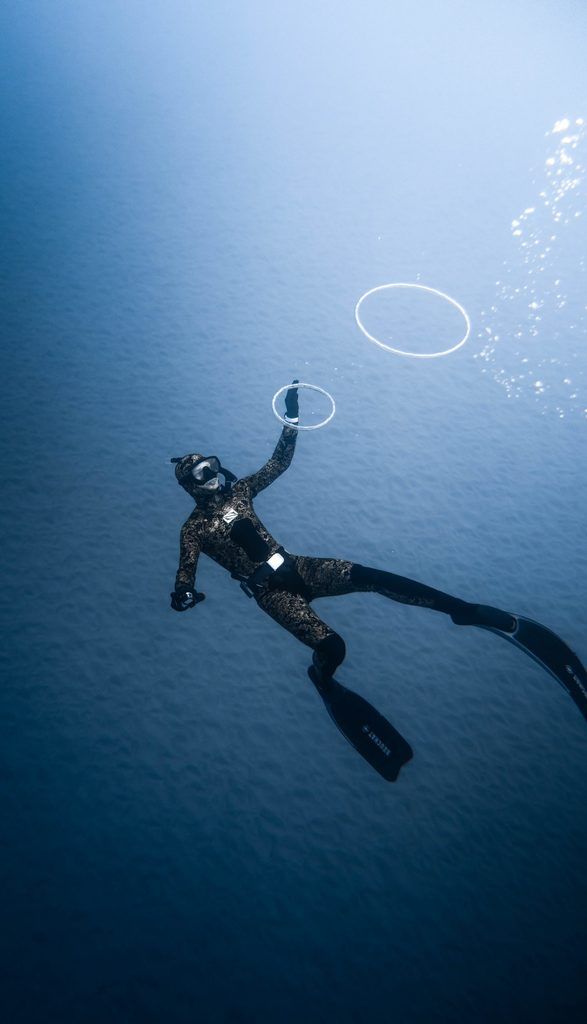
Does Camoflage spearfishing wetsuits work
Spearo’s seem divided on this question. Some believe that a camouflage spearfishing wetsuit does work others again say that it makes no difference to the fish and it is just for the spearo to look cool.
Our opinion is that camouflage does work but only if used correctly and almost never in isolation.
The idea with camouflage is that it should help you blend into your immediate surroundings.
Wearing a reef camo wetsuit while hanging around in the middle of the water column blowing bubble rings will not turn you invisible to your target fish species. But if you lay on or against a reef with a camo suit that have colors that match the reef then you are much more likely to go unnoticed by fish.
The way we see it is that many types of fish and other sea creatures like octopuses use camouflage to hide from their prey and potential predators. Octopuses are especially adept at it and they not only use color but also texture to turn themselves practically invisible.
Whether you are wearing a camouflage or a neon pink wetsuit you need to always remember two important things:
Fish can sense pressure changes and movement with their sensitive lateral lines so being able to keep still underwater is even more important than a realistic 3D camo wetsuit. And use your environment to your advantage - get completely flat on the bottom, go behind that boulder or get right against the reef structure to ensure you don't stand out like a sore thumb.
How to get into a open cell wetsuit
For open cell spearfishing and freediving wetsuits you need lubrication to get into it. Trying to do it without lube might tear your suit and, if you have body hair, pull some of it out in the process too.
Many spearo's use a water and hair conditioner solution as lube. An acqueos cream solution works just as well. Both are effective but not good for the environment, your wetsuit or even your skin.
There are alternatives on the market luckily.
Slippy is a powder concentrate that you mix with water to form a lubricant that is hypoallergenic, non-toxic, biodegradable. It has practically no odour and taste.
Shark Snot is an all natural lubemade from seaweed extract so there's nothing in it that wasn't in the ocean first. Completely Bio-degradable and kind to your skin, eyes and wetsuit.
We highly recommend using a spray bottel to apply your lube to your wetsuit and body. You will find that you waste a lot less lube when using a spray bottle to apply it compared to just pouring it into your wetsuit and sloshing it around.
Below is a quick how to video from the Team at Mako Spearguns to show you how to get into your Open Cell Wetsuit:
Who makes the best spearfishing wetsuit
This is a common but very tough questions. Like with most other "what is the best" type questions this will depend more on you than on the brand and type of wetsuit. And what's best for you won't necessarily be the best for someone else.
What will you be using the wetsuit for? How often do you dive? What's the water temperature? All questions that you need to consider to determine the best spearfishing wetsuit for you.
Most big manufacturers take good care to ensure that the wetsuits meet their strict quality control standards. With Custom suits the standards seem to be even higher.
All the manufacturers on our list make great wetsuits but there are many more local and smaller manufacturers whose wetsuits are just as good.
Environmentally friendly wetsuits
Traditionally wetsuits have always been made from neoprene a type of synthetic rubber produced by free-radical polymerization of chloroprene. The process is not exactly good for the environment and with the growing concern and global consciousness about renewable and zero impact living more companies are starting to offer environmentally friendly wetsuits.
Two companies at the forefront of this is:
Patagonia
This activist company is at the forefront of environmental and sustainable business practices and an example to all others. Using their business to protect nature they use Yulex® a natural rubber from the Hevea tree to make their wetsuits.
Fourth Element
Fourth Element's Ocean Positive range of wetsuits and swimwear are made from recycled plastic products which include plastic bottles and ghost fishing nets. Their Surface wetsuits are suitable for a variety of watersports including freediving. These suits are made from a certified sustainable natural rubber and recycled materials.
5 of the Best spearfishing wetsuits
Salvimar Wetsuits
The Italian manufacturer - Salvimar - makes some of the most beautiful spearfishing wetsuits on the market. Their camo patterns are very unique and the quality and attention to detail that they put in all of their gear is second to none.
Here are some of their most popular wetsuits:
All of the suits above have a nylon lining on the outside and open-cell interior. They also have load-pad on the chest area and a rubber protection layer called "puff -gum" on the chest and knees to protect the suit against abbrasion.
We are in the process of doing an in-depth review of the Salvimar Krypsis which we got our hands on so sign up for our newsletter to be the first to know when it goes live.
Epsealon Wetsuits
Epsealon makes a wide range of quality wetsuits but there is one that stands out above the others: The Epsealon Tactical Stealth Wetsuit.
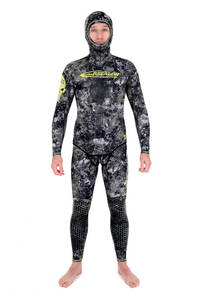

With its dark camo pattern and punisher skull on the chest and shoulder it is sure to intimidate your fellow divers and have them leave the biggest fish for you to spear...
Epsealon uses Yamamoto 039 in all of their wetsuits including the Tactical Stealth. The latter has a polyurethane coating on the knees, elbows, chest and bum to protect against abbrasions.
The exterior is lined with 4-way stretch nylon fabric and the interior is open-cell neoprene.
Elios Sub Wetsuits
Elios is a custom wetsuit manufacturer from Italy that uses a variety of different neoprene's depending on what you plan to do with the suit and the conditions that you'll normally use it in.
For spearfishing in rougher conditions where you need the extra protection and durability the Elios sub Mesh Skin is a great choice. It is much more durable than a smoothskin or the usual nylon outer that you get on lined wetsuits.
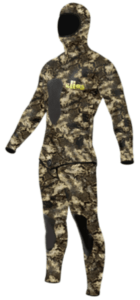
Source: EliosUSA.com
The Mesh skin has a thin layer of knurling that kind of reminds of the Shark Skin wetsuits of long ago. The knurls helps to make the wetsuit resistant to cuts and abbrasions. The rough surface is less hydrodynamic than a smoothskin suit but that won't be a problem except for the serious competivive freedivers.
Polosub Wetsuits
Polosub is tailored wetsuit manufacturer from Italy that specializes in Spearfishing and freediving wetuits. They know that a wetsuit is only effective when it fits you perfectly which is why all their suits are made to measure.
Their most popular product is their smoothskin open-cell wetsuits that's loved by competive freedivers and spearo from all over the world.
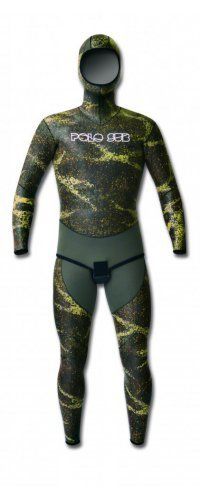
Source: Polosub.com
The PoloSub's Forza Tre wetsuits are made from a new material which consist of three layers. The inside layer is a soft open cell neoprene of varying thickness. The outer is a high density neoprene and in the center to hold the two together is a 2 way strecth fabric.
The Forza Tre (lit. Force Three or power of three) has the looks of a smoothskin wetsuit and the quick drying properties but thanks to the three layers it is much more durable and tear resistant.
Omer Wetsuits
The Italians just know how to do it. Omer is the 3rd Italian Manufacturer that made our list of the best spearfishing wetsuits.
Omer is one of the biggest and most popular manufacturers of the freediving and spearfishing gear. Their reputation for quality products is renowed around the world.
Most of their wetsuits, including the Blackstone featured above, are made from carefully selected neoprene. The exteriors are lined with Nylon while the interior is open cell.
They also have smoothskin suits and double lined wetsuits that sacrifice a little bit of warmth for durability and ease of use.
Conclusion
Let's be honest, choosing the best spearfishing wetsuit is a tough decision.
There are many great manufacturers out there that will gladly ship their wetsuits to you no matter where in the world you find yourself. There are just as many smaller local manufacturers that make equally great wetsuits for their loyal supporters.
There are some factors that differentiate one manufacturer from the other. Usually it is the materials that they use and their design or camo patterns that define them.
The material you choose should be dependent on how & where you plan to use your suit whereas the design and colors will also be affected by the areas you dive and your personal preference.
If you read this article upto here in the hope of getting a "buy this wetsuit" from it, then we might leave you a bit disappointed.
Any of the wetsuits listed above or those made by other great manufacturers like Wiahana, Riffe or the large European manufacturers like Seac or Cressi will serve you well as long as you choose one that suits your diving conditions.
Stick to manufacturers that actually make spearfishing gear as well and you won't be disappointed. As tempting as the low price is stay away from the cheap camo suits that have flooded the market from China. A wetsuit is an expensive purchase but a good one is well worth the money and will serve you well.
We hoped you enjoyed and found value in our Ultimate guide to Spearfishing wetsuits. If you did then please take a moment to share the article with your spearo buddies.





